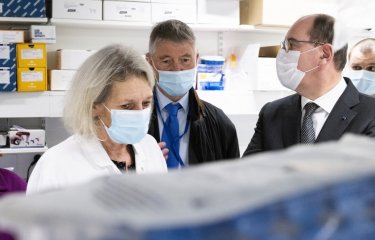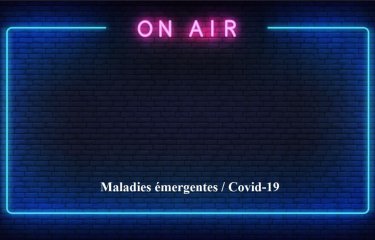It all started with a veterinarian and a cross-eyed lion
Jean-Claude Manuguerra was 7 when he decided that he wanted to become a veterinarian, to "save animals" – like in the TV series Daktari, which he was an avid fan of at the time. In the series, Dr. Marsh Tracy was a vet who cared for local animals and ran the Wameru Study Center for Animal Behavior in Kenya. Marsh Tracy was aided in his day-to-day work by a rather unusual team that included Clarence, a nonchalant squinty-eyed lion.
An inspiring meeting with his internship supervisor
In April 1986, as he was looking for a place to complete the final internship for his veterinary studies, Jean-Claude Manuguerra met Professor Claude Hannoun, who led the Viral Ecology Unit at the Institut Pasteur. The meeting had a real impact on him and inspired him to shift his focus in an unexpected direction. Jean-Claude was already interested in diseases that affected both animals and humans, like those transmitted by mosquitoes or ticks, but his internship supervisor explained that there was another virus that needed his attention even more. Although chikungunya was transmitted from mosquitoes to humans, it was not contagious between people. Influenza viruses, on the other hand, could be passed from animals to humans and then between humans, and they spread at lightning speed.
After this conversation, the virologist encouraged Jean-Claude to read a scientific treatise on virology in English, a text that has stayed in his memory and that he still treasures to this day. (The Influenza Viruses and Influenza by Edwin D. Kilbourne, 1975)
From farm to post-doc
"At that time, I had already completed several internships on farms, and I had a Saturday job at a veterinary clinic in Paris. Although I was enjoying the profession, when I had to begin my practical thesis for my MD in Veterinary Science at the same time as my Master's degree, the workload forced me to put my veterinary activities to one side for a while. And then I had to make a choice: I could either stop my university studies or embark on a PhD in science."
"I told myself that scientific research in a laboratory was an opportunity that might not come my way again! So I started work on my second thesis."
After his PhD, he went to the UK to complete a post-doctoral fellowship in a renowned laboratory led by Dr. John Skehel at the National Institute for Medical Research in Mill Hill, North London. It was at this institute that human influenza was first identified in 1933, and Jean-Claude's research focused in turn on equine and swine influenza.
Following migratory birds
When he returned to Paris, the Institut Pasteur asked if he would be interested in taking over as acting Director of the National Reference Center (CNR) for Influenza and acting Head of the Viral Ecology Unit following Claude Hannoun's retirement. He accepted. In the Viral Ecology laboratory, his first work was on influenza viruses – specifically avian influenza. The young scientist went to the Marquenterre nature park in the Bay of Somme to take samples from migratory birds. His task was to measure bird populations, take samples and get to know the different types of virus that were circulating. Back in the lab, the viruses were analyzed, monitored to see whether or not there were any new mutations, and compared with human influenza. This basic virological knowledge would provide a crucial foundation for tackling disease.
Although the viruses that Jean-Claude was studying still had their reservoir in animals, history had shown that in some circumstances these viruses could cross the species barrier and adapt to humans.
Emerging diseases worldwide
Alongside his research unit, Jean-Claude is also Director of the Laboratory for Urgent Response to Biological Threats (CIBU). The CIBU analyzes samples sent to it by France's Regional Health Agencies. These samples may contain infectious agents such as anthrax or plague bacteria or the Ebola, Marburg, Crimean-Congo, Lassa or Nipah viruses, for example.
The CIBU's various tasks include responding to disease outbreaks at international level. When outbreaks occur, Jean-Claude and his team members set off across the world, taking with them a fully equipped mobile laboratory.
In 2003, the French Health Ministry asked the team to go to Hanoi, together with the French emergency medical service (SAMU), to investigate an unknown respiratory virus that had caused an outbreak of SARS (severe acute respiratory syndrome). This novel virus would go on to paralyze several countries in Asia, especially Hong Kong. People's movements were limited, masks become mandatory, and the World Health Organization (WHO) feared a global health crisis.

Jean-Claude Manuguerra,
Head of environment and infectious risks unit.
"We worked with Hanoi hospital to take samples. At the end of our mission, we were placed in quarantine and were unable to leave the city.
The situation was worrying – there were no diagnostic tests at that stage. If we fell ill, there were no hospitals up to international standards to treat us, and there was no question of repatriating us to France in case we were contagious!
Since then, whenever an epidemic strikes, anywhere in the world, Jean-Claude and his team are on hand to respond.
- 2004, an avian influenza outbreak struck Cambodia.
- 2009, influenza A(H1N1) and swine influenza emerged in Mexico.
- 2012, a novel respiratory coronavirus was declared in the Middle East (MERS-CoV).
- 2014, the first Ebola virus outbreak hit West Africa and was the largest Ebola outbreak ever observed. Jean-Claude and seven members of his team were deployed to Guinea, first to Conakry and then in 2015 to Macenta. They barely had time to catch their breath before three CIBU members were sent to the Republic of the Congo, to Brazzaville, which was experiencing a yellow fever outbreak.
- And more recently there has been the emergence of the Zika virus and the virus that causes COVID-19.
In 2020, before diagnostic tests had been developed for COVID-19, the entire team stepped up, working on-call shifts overnight and at the weekend to identify the novel coronavirus in the many samples that the CIBU received when the National Reference Center was closed.

This year we will be celebrating the CIBU's 20th anniversary. The laboratory has changed over the years – we have developed several scientific partnerships, and from the start we have been involved in the Global Outbreak Alert and Response Network."
"Although the work is sometimes intense and challenging, the various crises and field missions have made us stronger as a team. We share a unique working dynamic that galvanizes our commitment to health and science.
|
The Laboratory for Urgent Response to Biological Threats has an on-call system, with 17 scientific and technical experts available 24/7, all year round, to respond to microbiological emergencies that could endanger public health in France. The laboratory was set up in late 2002, in a climate dominated by the tragic attacks in New York on September 11, 2001, and also by bioterrorist threats involving anthrax (whether proven or not) in France and the United States. Over the past two decades, the CIBU has been occupied by other major challenges, with a succession of large-scale epidemic crises worldwide – and especially that most unexpected of pandemics, COVID-19. |
Key dates in Jean-Claude Manuguerra's career
2000-2018: Institut Pasteur representative on the Steering Committee of the Global Outbreak Alert and Response Network (GOARN)
2007-2007: Paris-Sud University – Accreditation to supervise research – Virology
1989-1992: Paris-Sud University – PhD in Pharmaceutical Science, Microbial Ecology and Antimicrobial Agents
1991-1991: Institut Pasteur course in Genetic Engineering
1988-1989: University Paris-Est Créteil (UPEC) – MD in Veterinary Science
1988-1988: Institut Pasteur Diploma in Medical Virology
1986-1987: Paris-Sud University – DEA (Master's degree) in Microbial Ecology and Antimicrobials
1982-1986: Alfort National Veterinary School – veterinary studies
Prizes and awards
2010: Editorial award – Continuing education article in veterinary journals – Syndicat de la Presse et de l'Edition des Professions de Santé (Press and Publishing Union for Health Professions – SPEPS)
2007: Chevalier of the Legion of Honor
2003: Chevalier of the National Order of Merit
1992: Joint winner of the best thesis award and Laureate of the Faculty of Pharmacy at Paris-Sud University
1989: Thesis medal (bronze) and Laureate of Alfort National Veterinary School






